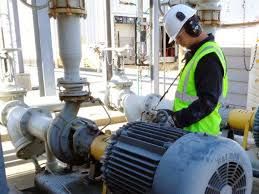What is the Cost of NOT Doing Scheduled Reliability Maintenance?

The global predictive maintenance market is expected to grow rapidly from $4.5 billion in 2020 to $64.3 billion in 2030, according to consulting group NextMSC. This serves as evidence that more and more facilities are implementing predictive maintenance (PdM) and reliability services. Still, not everyone is convinced that it’s worthwhile and cost-effective for their facilities.
So, let’s talk a bit about the cost of not doing scheduled reliability services. But first, a quick review on what PdM is and how scheduled reliability services fit in.
What is Predictive Maintenance
The intent of predictive maintenance (usually abbreviated PdM) is to predict when a failure will occur and prevent it through maintenance. Maintenance can then be scheduled at a time when it will have minimum impact on the productivity of your facility. This type of maintenance enhances the reliability of both the equipment you are responsible for and your facility — which means they are essentially reliability services.
Costs of Not Implementing Scheduled Reliability Services
Here are some of the direct and indirect costs that go along with neglecting scheduled reliability services.
Disruption and Shutdown
Any time equipment fails, it disrupts operation at your facility. That disruption is minimal and can be addressed quickly if you’re fortunate. However, the failure of a critical machine can lead to the shutdown of other equipment, which can mean more extensive disruption and downtime costs. Depending on what fails, the result can be a domino effect through your facility.
Not Getting Maximum Use Out of Your Equipment
Failing to take advantage of scheduled reliability services will shorten the life of your equipment. Take as an example lubrication: experts estimate that 80% of mechanical wear is due to particle contamination in lubricants. While some mechanical wear is inevitable, accelerated wear can be avoided by following industry best practices for lubrication. In addition, imbalances, vibration, and misalignments in your equipment can also lead to accelerated wear and other problems that shorten the useful life of components.
Voided Warranties
Warranties assume that the equipment will be reasonably maintained. If you fail to maintain your equipment, you may think that no one will be able to tell — but experienced technicians can. If your equipment fails and you attempt to use your warranty, you’ll quickly discover that failure to maintain will void your valuable warranties. On the other hand, implementing PdM maintenance and reliability practices can keep your machines within the constraints of their warranties. That way, you get your money’s worth for the warranty.
Problems Going Unnoticed
Neglecting to follow through on PdM and scheduled reliability services means that problems will go unnoticed. And remember, what starts as a low-impact issue, a low-cost repair can quickly transform into an expensive repair, high-impact repair. For example, bearing wear can be detected through vibration analysis. Failure to replace a worn-out bearing in an electric motor will lead to catastrophic failure and a domino effect of problems in your drive train.
Examples of PdM
What follows are three examples of PdM services and how they can support the reliability of your equipment, reduce downtime, and lower repair and operating costs.
Thermal Scans
Let’s start with thermal scans as part of a regular reliability service. Collecting thermal scan data over time can reveal the development of problems such as electrical unbalance, high resistance, excessive current flow, or system overload. Implementing thermal cameras as part of a scheduled PdM reliability service effectively flags developing problems such as these. This allows such issues to be addressed before they worsen and cause extensive damage.
Motor Shaft Alignments
Motor shaft alignments are another aspect of PdM. According to the US DOE (Department of Energy), newly installed equipment should be checked after 3 to 6 months of use for alignment changes resulting from the foundation settling. They also recommend an annual shaft alignment check for production-critical equipment. And that’s not all: the DOE advises everyone to …
“Apply predictive maintenance techniques, including vibration tests and frequency spectrum analysis, to distinguish between bearing wear, shaft misalignment, or electrically-caused vibrations.”
Vibration Analysis
You probably noticed a reference to vibration analysis in that quote. Vibration can reveal a great deal of information about the condition of your equipment. Abnormal vibration patterns, for example, can reveal the presence of bearing faults, lubrication issues, and misalignment. Vibration analysis can provide critical information about rotating machines (e.g., motors, fans, gearboxes), rotating components (gears, shafts, bearings), and reciprocating machines (compressors, pumps, door mechanisms) as well. Route-based, periodic vibration monitoring collects vibration data so that condition benchmarks can be obtained and abnormalities can be quickly detected.
Conclusion
According to the Deloitte Analytics Institute report on Predictive Maintenance, predictive maintenance can, on average, reduce breakdowns by 70%, increase productivity by 25%, and lower maintenance costs by 25%.
This translates to significantly fewer breakdowns, which also means reduced costs associated with downtime and repairs. Productivity is increased because your critical equipment is more reliable and efficient. And maintenance costs go down because maintenance is performed as needed and scheduled to have a minimum impact on productivity.
At Hi-Speed Industrial Service we want to be your predictive maintenance provider. We offer oil analysis, thermal scans, ultrasonic analysis, motor shaft alignments, vibration analysis, motion amplification, and more. Our team will work with you to develop a custom PdM schedule for your facility that meets your needs and goals. Contact Hi-Speed today to learn more about how we can help maintain the reliability of your equipment.

